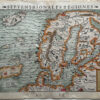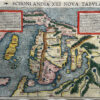Gerard van Keulen (1678 – 1726)
was a Dutch cartographer and publisher who mainly produced nautical charts and atlases in the tradition of his father Johannes van Keulen (1654 – 1715), the founder of a firm which should become the biggest and most influential name in the history of Dutch sea charts.
Born in Deventer, Johannes established himself in Amsterdam in 1678. In 1680 he gained privilege from the States of Holland and West Friesland for the publication of pilot guides and sea atlases. In that year Johannes released the „Zee-Atlas. De groote nieuwe vermeerderde Zee-Atlas ofte Water-Wereld“ which became immensely popular and was steadily re-produced until 1734. In 1681 „De Niewe Groote Ligtende Zee-Fakkel“ (Shining Sea-Torch) appeared. The atlas had charts compiled by Claes Jansz. Vooght and artwork from Jan Luyken. This five-volume work was published in several editions until 1685 and made Johannes van Keulen famous. There were translations in French, English, Spanish and Italian language.
His son Gerard was endowed with talent and by doing an internship with his father, Gerard became a skillful engraver. He was also proficient in mathematics and navigation and established the scientific basis of the van Keulen firm. In 1714 he was appointed hydrographer to the Dutch East India Company and the family remained chart makers until the company‘s liquidation.
After Gerard van Keulen’s death at the age of only 49 years, his son Johannes II. van Keulen (1704 – 1755) carried on the business. He is known in particular for his publication in 1753 of a sixth volume of the „Zee-Fakkel“ which contained new charts of the route to the East Indies and was re-printed until 1773.
When Johannes van Keulen the Younger died, his son Gerald Hulst van Keulen (1733 – 1801),great grandson of the founder of the „Empire“, took over the firm. He was responsible for publishing the final true van Keulen editions of the family‘s signature product, the „Zee-Fakkel“. When he died the business was continued by his son Johannes Hulst van Keulen and after his death in 1844 the firm passed out of family hands and flourished under different names until 1885.
Map details
This extremely rare chart of Iceland „is undated, but was probably made some time around 1720. The basis is the map of Iceland by Joris Carolus, not other sea charts by the van Keulens“ (islandskort.is) and was most likely published in one of the editions of the „Zee-Fakkel“.
The title of this detailed and beautifully coloured map is placed on top of the map. Rhumb lines are intersecting three compass roses, two in the ocean and one in the interior of the country. There are two distance scales in the lower left corner. Above them is an information on the author, his address and his patent: „te Amsterdam by Gerard van Keulen, Aan de Nieuwen Brugh met Privilegie“.
In the interior of the island numerous fjords, mountains, rivers and lakes and also some settlements are depicted. The bishoprics Skalholt and Holar are highlighted with triform cathedrals: Skalholt bigger and with the inscription „Hoofdstadt van Ysland“ (Capital of Iceland) and Holar („Halar“) smaller with the inscription „Bischoppeleke Stadt en hoogescheel“ (???). Another triform small cathedral is „Haner of Haver“ (probably Hafnarfjördur). Spectacular is the depiction of the famous volcano („den Bergh Hekla“) with the comment: „dees Berg brand niet meer heeft in‘t Iaar 1692 opgehouden“ (this mountain does not burn any more since 1692). Astonishingly many glaciers („hokell“) have names. Some are easy to identify e.g. „Solheima“, others not e.g. „Amcopeltz“.
In the west of Iceland „Goubermans Eylanden of Klippen“ are to be seen which do not exist in reality. North of the Westfjords an area is named „Zee Gronden“, probably a warning of shallow waters. The Arctic Circle is drawn completely wrong.



